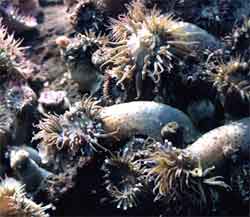Anemone Armies Battle to a Standoff

Warrior anemones reach over from several rows behind the front to attack animals from a neighboring colony. (Rick Grosberg/UC Davis photo)
Clashing colonies of sea anemones fight as organized armies with distinct castes of warriors, scouts, reproductives and other types, according to a new study.
The sea anemone Anthopleura elegantissima lives in large colonies of genetically identical clones on boulders around the tide line. Where two colonies meet they form a distinct boundary zone. Anemones that contact an animal from another colony will fight, hitting each other with special tentacles that leave patches of stinging cells stuck to their opponent.
David J. Ayre from the University of Wollongong, Australia, and Rick Grosberg from UC Davis have previously taken individual anemone polyps from separate colonies and studied fighting strategies one-on-one. But that’s like trying to understand two armies by taking a single soldier from each side, Grosberg said.
Now, the researchers have been able to study two entire colonies as they clash.
When the tide is out, the polyps are contracted and quiet. As the tide covers the colonies, “scouts” move out into the border to look for empty space to occupy. Larger, well-armed “warriors” inflate their stinging arms and swing them around. Towards the center of the colony, poorly armed “reproductive” anemones stay out of the fray and conduct the clone’s business of breeding.
When anemones from opposing colonies come in contact, they usually fight. But after about 20 or 30 minutes of battle the clones settle down to a truce until the next high tide.
It’s not just polyps along the border between two clones that clash. Polyps three or four rows away from the front will reach over their comrades to engage in fights, Grosberg said.
Differentiation into warriors seems to depend on a combination of signals from enemy stings and the genetics of the colony. Different colonies react differently to similar signals, explaining why different clones are organized into so many different kinds of armies. But borders between colonies can remain stable for years, even though the two colonies organize their armies in different ways.
The study shows that very complex, sophisticated, and coordinated behaviors can emerge at the level of the group, even when the group members are very simple organisms with nothing resembling a brain, Grosberg said. The research was published in the June issue of the journal Animal Behaviour.
Media Contact
More Information:
http://www.ucdavis.eduAll latest news from the category: Life Sciences and Chemistry
Articles and reports from the Life Sciences and chemistry area deal with applied and basic research into modern biology, chemistry and human medicine.
Valuable information can be found on a range of life sciences fields including bacteriology, biochemistry, bionics, bioinformatics, biophysics, biotechnology, genetics, geobotany, human biology, marine biology, microbiology, molecular biology, cellular biology, zoology, bioinorganic chemistry, microchemistry and environmental chemistry.
Newest articles

Properties of new materials for microchips
… can now be measured well. Reseachers of Delft University of Technology demonstrated measuring performance properties of ultrathin silicon membranes. Making ever smaller and more powerful chips requires new ultrathin…

Floating solar’s potential
… to support sustainable development by addressing climate, water, and energy goals holistically. A new study published this week in Nature Energy raises the potential for floating solar photovoltaics (FPV)…

Skyrmions move at record speeds
… a step towards the computing of the future. An international research team led by scientists from the CNRS1 has discovered that the magnetic nanobubbles2 known as skyrmions can be…





















